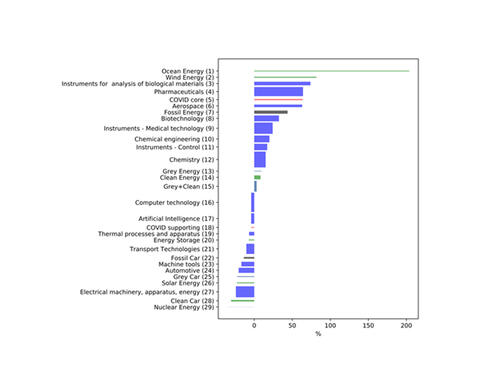
Written by
Published
Category
Key topics
A sustainable growth strategy can achieve net zero emissions, improve productivity and contribute to levelling up
In the recovery from coronavirus (COVID-19), innovation and its diffusion will be key to addressing several structural challenges facing the UK economy. These include improving the UK’s longstanding poor productivity performance, addressing large-scale disparities across and within regions, and reorientating the economy to reach net-zero emissions of greenhouse gases by 2050.
The health and economic impacts of the pandemic have already devastated lives and livelihoods, and continue to do so. As yet, the timing and shape of the economic recovery remain uncertain with significant risks of long-term damage to productivity growth. Private sector investment in innovation typically suffers in downturns, particularly in financially constrained firms, and prolonged disruptions in education and work can lead to labour market “scarring”.
But the pandemic has also opened a window of opportunity. Innovation and its diffusion have already played an important role in the global response to the pandemic, with rapid progress on the development of COVID-19 vaccines and treatment, and more generally via the increased adoption of digital technologies that have allowed businesses and individuals to adapt to social distancing requirements. Political support for government spending to soften the blow of this crisis appears to be larger than in the aftermath of the 2008 financial crisis, and many have talked about taking this chance to invest in productive and sustainable assets that will allow us to “build back better”.
The UK government has pointed at innovation as a cornerstone in its recovery strategy, with its R&D Roadmap published in the midst of the crisis. Given mounting pressures on government budgets, this raises the question of how to efficiently allocate R&D support to address the major socioeconomic challenges facing the UK and global economies.
Supporting R&D in biotech and clean energy
In our recent paper on “Innovation for a Strong and Sustainable Recovery”, we analyse the UK’s strengths in innovation using patent data in order to examine the potential of addressing multiple challenges simultaneously. We find that the UK has relative strengths in specific clean technologies such as wind and ocean energy production, as well as “COVID-related” technologies such as biotechnology and pharmaceuticals. The UK’s “revealed technological advantage” (RTA) compared to the rest of the world in key areas of innovation over the period 2005 to 2014 is set out in Figure 1. Reassuringly, this shows the UK innovation system is well placed to help address the concurrent and global climate and public health challenges.

Figure 1. UK “revealed technological advantage” in key areas of innovation compared with the rest of the world (2005–14)
Note: The length of each bar on the horizontal axis shows the RTA; the width of each bar on the vertical axis reflects the number of patents in each category. RTA is defined as the share of an economy’s patents in a particular technology field relative to the global share of patents in that field. This gives an indication of the relative specialisation of a given country in different categories of technology: an RTA above one suggests the UK specialises in that particular area. Source: Authors’ estimates based on PATSTAT.
We also examine regional differences in innovative activity (Figure 2) and find that the areas that specialise in COVID-related innovation tend to also be places where a large share of overall UK innovation occurs, including the golden triangle and parts of Scotland. On the other hand, areas that specialise in cleantech are more spread out, and include the Midlands and North of England. This analysis suggests support for clean technologies could contribute to efforts to level up the UK.

Figure 2. Distribution of patenting across Great Britain
Note: Panel A gives the share of total patents by NUTS2 region. Panels B and C show the share of each region’s innovation that is “COVID-related” and clean, respectively. COVID-relevant includes COVID core and COVID supporting as previously defined. The analysis covers the period 2004–14. Source: Authors’ estimates based on PATSTAT.
But how would increased support for clean or COVID-related technologies affect overall growth, particularly if it came at the expense of support for other technology areas? To help answer this, we have developed a new methodology that estimates the national return of government support for different areas. Our methodology accounts for variation in the private returns of different technology areas and also accounts for (localised) innovation spillovers (one of the principal reasons firms underinvest in R&D relative to the amount of investment that might be considered optimal from society’s perspective). Figure 3 summarises the results. We find that our “return on investment” indicator is particularly high for COVID-related technologies, together with wind and ocean renewable energy technologies.

Figure 3. UK returns to public R&D investments across technologies, 2005–14
Note: The figure reports average returns to public R&D subsidies by technology area. The calculations account for direct and indirect knowledge spillovers occurring within the UK, variations in private R&D returns, variation in R&D costs and differences in the responsiveness to subsidies between different technology areas. This is based on the "IStra-X" indicator as developed by Guillard et al. 2020. The length of each bar on the horizontal axis shows the IStra-X value; the depth of each bar on the vertical axis shows the number of patents in each category. Source: Authors’ estimates based on PATSTAT.
This analysis suggests relocating government support towards these areas is not only desirable because of health and climate benefits but could also have immediate growth benefits. Hence, in the case of clean technologies, we have a triple win with climate, growth and levelling up benefits.
Strong government leadership and coherent policy is needed to grasp this innovation opportunity
Evidence has shown that, despite the potential economic advantages in “clean” technologies, strong inertia in behaviours and processes, and high switching costs make it difficult to shift the innovation system from incumbent dirty to clean technologies without direct policy intervention. Such difficulties are likely to be all the more pronounced in a downturn, and this highlights the importance of policy credibility to guide investor expectations at this time. Boosting innovation and steering its direction requires a combination of a coherent long-term vision and complementary short-term delivery mechanisms to create new markets.
The UK government’s “Ten Point Plan for a Green Industrial Revolution” provides a signal on the direction of future investment and growth. This needs to be accelerated and complemented with consistent and long-term innovation and industrial policies to facilitate transition to sustainable business models, investments and related innovation. On the supply-side, this includes support for both private and public R&D in outlined areas, complementary investment in infrastructure and skills, and efforts to strengthen international partnerships and maintain the UK’s attractiveness as a destination for investment and talent. These measures must be complemented by strong demand-side incentives and regulation to stimulate and shape markets in the technologies of the future.
The forthcoming R&D place strategy provides a key opportunity to realise these ambitions, ensuring the relevant policy levers at the national and local level are aligned and based on a deeper understanding of local strengths, challenges, and evidence of what works for improving innovation-led growth in different contexts.
This article originally appeared on LSE Business Review.



